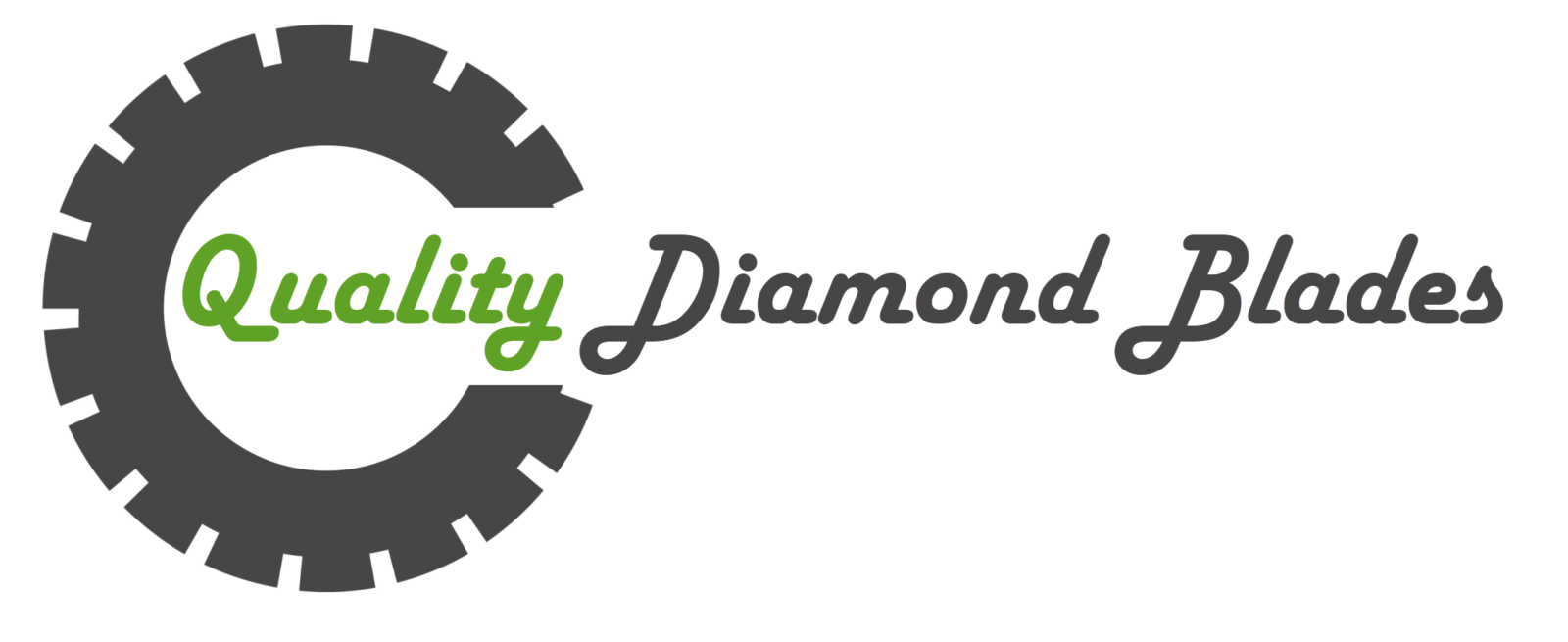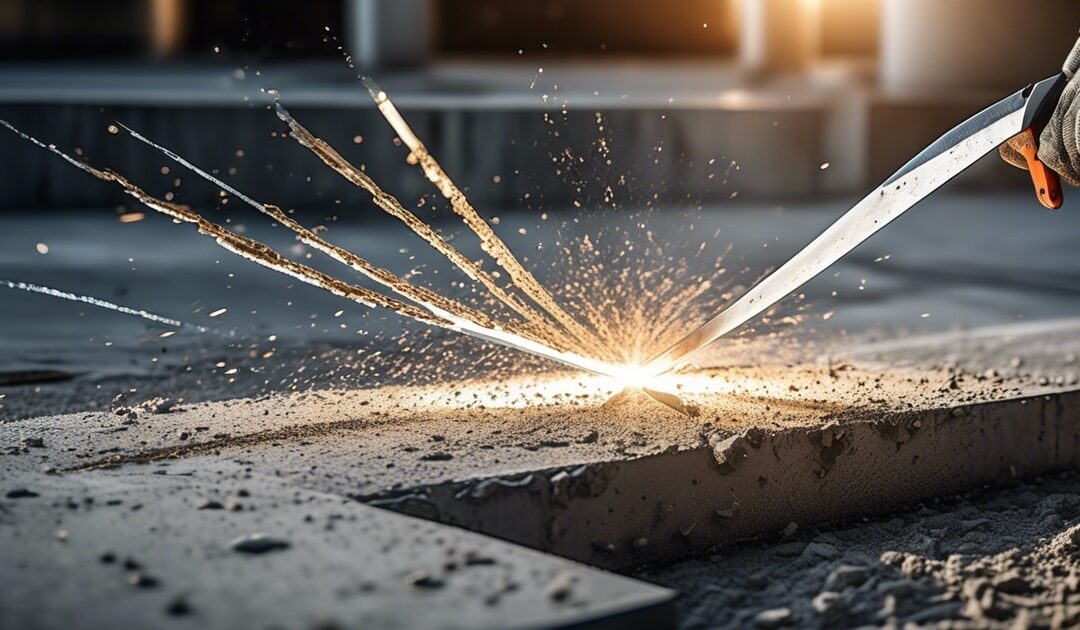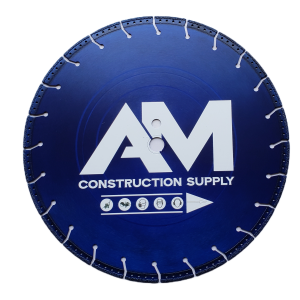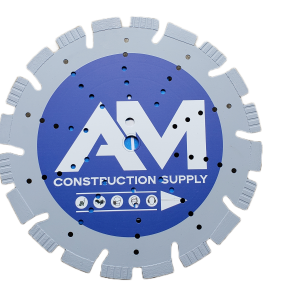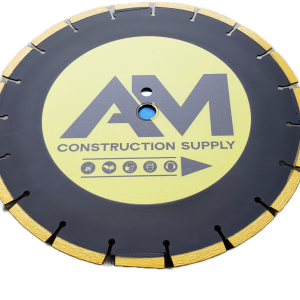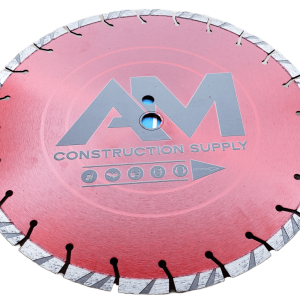Ever wondered how professionals slice through concrete slabs like butter? The secret lies in their choice of blade, but navigating the sea of options can be overwhelming. Whether you’re a DIY enthusiast tackling a home project or a seasoned contractor seeking to enhance efficiency, selecting the right blade is crucial. This post dives deep into the world of concrete blades, shedding light on which ones truly stand out for durability, precision, and overall performance. By understanding the key features, including the tip, that set the best blades apart, you’ll be equipped to make an informed decision for your next concrete cutting task. Let’s cut through the confusion and discover what makes a blade superior for slicing through concrete slabs.
Key Takeaways
- The best blade for cutting concrete slabs depends on the specific job requirements, including the type of concrete and the desired finish.
- Turbo-rim blades offer a good balance between speed and finish quality, making them suitable for both dry and wet cutting applications.
- Segmented blades are ideal for jobs requiring fast cutting with less concern for the smoothness of the cut edge.
- Continuous rim blades provide the cleanest cuts, perfect for projects where precision is paramount, such as in tile or decorative concrete work.
- Abrasive blades are a cost-effective option for rough cutting, but they wear down quickly compared to diamond-tipped blades.
- When choosing a blade, consider not only the type of concrete and desired outcome but also the quality of the blade. Investing in a high-quality diamond blade can result in better performance and longer life.
Understanding Concrete Blades
Blade Types
Cutting a concrete slab requires precision and the right tools. Carbide-tipped blades for the right concrete saw stand out for their durability and efficiency. They easily cut through tough materials without wearing down quickly. This makes them ideal for concrete cutting tasks.
There are two main blade types to consider: thin-kerf ripping and combination blades. Thin-kerf ripping blades are designed for making fast, clean cuts through concrete slabs. They have fewer teeth and a narrow kerf, reducing resistance and requiring less power from the saw. On the other hand, combination blades offer versatility. They can perform both ripping and crosscutting tasks but may not be as efficient in specific situations as a specialized blade.
Choosing the right blade type is crucial. It ensures that the task at hand is completed efficiently and with precision. Whether it’s a thin-kerf blade for speedy cuts or a combination blade for various tasks, selecting appropriately can make all the difference.
Cutting Techniques
Adjusting the base plate of your saw is key for parallel cuts. This ensures that the blade runs exactly alongside the edge of your workpiece, resulting in straight, uniform cuts.
Using a saw edge guide can further enhance accuracy in straight cuts. The guide acts as a reference point, ensuring that every pass of the blade remains consistent with the last. This technique is invaluable for maintaining straight lines over long distances.
The depth of the blade also plays a vital role in achieving accurate cuts. By adjusting how deep the blade penetrates into the concrete slab, you can avoid undercuts or unnecessary wear on your tool. Proper depth adjustment ensures clean cuts and extends the lifespan of your blades.
Material Considerations
Concrete composition significantly affects which blade should be used. High-density concretes require stronger, more durable blades to cut effectively without rapid wear.
Aggregate hardness directly impacts blade wear as well. Harder aggregates like quartz will dull blades faster than softer materials like limestone. Choosing a blade suited to the hardness of your concrete will reduce wear and tear, saving time and money.
Lastly, considering the concrete slab’s age and density is essential when selecting a blade. Older concrete tends to be harder, requiring more robust blades than those used for cutting newer slabs. Similarly, denser concretes demand blades designed to handle such materials without losing effectiveness or damaging the tool.
Turbo-Rim Blade Explained
Efficiency
Turbo-rim blades are known for their efficiency in concrete cutting. They work well with power feed systems, ensuring consistent cuts every time. This setup is crucial for professionals who value precision and speed.
The alignment of the blade and saw plays a significant role in saving time. A properly aligned system reduces the effort needed to make clean cuts. It also minimizes wear on the equipment.
Choosing the right turbo-rim blade can eliminate the need for multiple passes through the material. This not only saves time but also reduces wear on the tools. With fewer cuts needed, projects can move forward more quickly.
Applications
Turbo-rim blades shine in various applications due to their versatility. For decorative concrete cutting, these blades offer precision without damaging the aesthetics of the surface. Their design allows for intricate patterns to be cut with ease.
In indoor environments, wet cutting blades are preferable. They help in reducing dust, making them ideal for enclosed spaces where air quality is a concern. These blades ensure that workspaces remain clean and safe for workers.
For tougher materials like reinforced concrete, certain turbo-rim blades are designed to handle such challenges. Their robust construction allows them to cut through metal reinforcements without losing efficiency or speed.
Limitations
Despite their versatility, turbo-rim blades have limitations too. Thin-kerf blades may struggle in heavy-duty cutting scenarios. They can wear out faster when used on dense materials or for prolonged periods.
Blade deflection is another issue that can arise if slabs are not properly supported during cutting operations. This can lead to inaccurate cuts and potential damage to both the blade and material.
Understanding these limitations is crucial to prevent damage to your tools and workpieces. Choosing the right blade for the job ensures longevity and efficiency in your projects.
Segmented Blade Features
Design Benefits
Segments in a blade play a crucial role in cutting concrete slabs. They are typically carbide-tipped, offering a longer lifespan and durability. This is because carbide resists wear better than other materials when cutting through tough concrete.
The design of segmented blades also minimizes vibration. This leads to smoother operations and enhances cut quality. Users benefit from less fatigue and better control during long cutting sessions.
Safety is paramount in concrete cutting. Segmented blades often feature anti-kickback designs. These designs prevent the blade from becoming lodged in the concrete, reducing the risk of injury.
Cutting Speed
The choice of blade significantly affects cutting speed. Segmented blades, with their unique design, allow for faster cuts through concrete slabs compared to other types, like turbo-rim blades discussed previously.
Blade tooth count plays a part in this equation too. More teeth can mean a smoother finish but might reduce the speed of the cut. Fewer teeth increase speed but might not leave as smooth a finish.
Matching the cutting speed to the hardness of the concrete is crucial. Harder concrete requires a blade that can cut at an appropriate speed without wearing down too quickly or overheating.
Durability
Several factors contribute to the durability of a segmented blade. The material from which it’s made is primary among these. Carbide-tipped segments withstand the abrasive nature of concrete well.
Proper maintenance also extends blade life. Regular cleaning and inspection for wear can prevent premature failure.
The cutting technique impacts wear and tear on the blade too. Forcing the blade through the material or using it at incorrect speeds can degrade its lifespan quickly.
Continuous Rim Advantages
Precise Cuts
For those aiming for perfection in their concrete cutting tasks, alignment is key. A blade that’s perfectly aligned ensures cuts are as accurate as possible. This precision is crucial when working on projects where every millimeter counts.
Stable rip fences play a significant role in maintaining this accuracy. They guide the blade, ensuring it stays on the intended path without deviation. This steadiness is vital for achieving clean, straight cuts.
Moreover, using a sliding table can enhance precision for cross cuts. It allows for smoother movement of the concrete slab against the blade, resulting in sharper and more precise cuts. The combination of these tools and techniques significantly improves the quality of the final workpiece.
Wet Cutting
Wet cutting offers considerable advantages, especially in terms of dust control and cooling the blade. By applying water to the cutting area, dust particles bind with water droplets, greatly reducing the amount of airborne dust. This not only creates a cleaner working environment but also protects the health of operators by minimizing inhalation of silica dust.
Using water-resistant blades is essential for wet cutting processes. These blades are designed to withstand corrosion and rusting that could compromise their integrity and performance over time.
Wet cutting has notable environmental benefits. It helps in mitigating air pollution by preventing concrete dust from dispersing into the atmosphere. This practice contributes to healthier work sites and surrounding areas by keeping air quality at safer levels.
Material Compatibility
It’s crucial to select blades that are compatible with the concrete’s aggregate type. Concrete aggregates vary widely, and each type affects how a blade performs during cutting operations. Choosing a matching blade ensures efficient cutting and optimal results.
The right blade compatibility not only maximizes efficiency but also extends the life of both the blade and saw equipment. Conversely, using incompatible blades can lead to poor performance, increased wear on tools, and potentially unsafe working conditions.
Risks associated with using incompatible blades include ineffective cuts, potential damage to the concrete slab, and increased chances of blade failure. These issues underscore the importance of proper selection based on material compatibility before beginning any cutting task.
Abrasive Blade Overview
Cost-Effectiveness
Investing in high-quality abrasive blades can lead to significant long-term cost savings. The initial price might be higher, but the extended lifespan of these blades balances out the upfront costs. They cut through concrete slabs efficiently, reducing the time and energy needed for projects.
Proper cutting techniques also play a crucial role in minimizing expenses. By optimizing how these blades are used, workers can cut more accurately and with less waste. This precision ultimately lowers the overall project costs by saving on both materials and labor.
Usage Tips
To maximize the life of abrasive blades, proper use and maintenance are key. Regular cleaning and storing them in appropriate conditions prevent premature wear. Also, ensuring that they are correctly installed on cutting equipment helps maintain their integrity.
Safety and efficiency depend on regular blade inspections. Small cracks or signs of wear can lead to dangerous situations if left unchecked. Adjusting cutting techniques based on the hardness of the concrete can also extend blade life. Softer materials require less force, while harder surfaces might need a slower cutting speed to avoid overheating the blade.
Wear and Tear
Abrasive blades face constant wear from cutting through tough materials like concrete slabs. Signs of wear include decreased cutting performance, visible damage to the blade’s edges, or unusual vibrations during use. To mitigate this wear, users should choose blades suited to their specific tasks.
The impact of abrasive materials on blade longevity cannot be overstressed. Constant exposure to harsh elements accelerates deterioration. Thus, selecting the right type of blade for each job is crucial to minimize this effect and ensure optimal performance over time.
Circular Saw Blade Uses
Versatility
Choosing a circular saw blade for cutting concrete slabs requires considering its versatility. Blades designed for multi-material cutting, including concrete, offer significant benefits. They allow users to switch between different project materials without changing blades. This flexibility saves time and reduces the need for multiple, specialized blades.
However, there’s a trade-off. Versatile blades may not perform as well in specific tasks as those designed solely for concrete. While they cut through various materials, their efficiency in concrete might be slightly lower than specialized blades. Still, for many DIYers and general contractors, the convenience of a versatile blade outweighs this slight dip in performance.
Power Tools Compatibility
Matching your circular saw blade with the correct power tool model is crucial. The power of the tool impacts how effectively the blade cuts through concrete. A mismatch can lead to poor cutting results or even damage the blade and tool.
To ensure compatibility, always check the manufacturer’s specifications for both the blade and power tool. This step guarantees that the blade fits perfectly and operates at optimal efficiency. It also ensures safe operation, reducing the risk of accidents due to incompatible equipment.
Safety Measures
Safety should always be a priority when handling and installing concrete cutting blades. Proper safety precautions include ensuring that the blade is securely attached to the power tool. Also, look for blades with anti-kickback features. These designs reduce the risk of the blade binding in the material, which can cause dangerous kickbacks.
Personal protective equipment (PPE) plays a vital role during cutting operations. Wear goggles to protect your eyes from debris, ear protection to guard against noise, and gloves to keep your hands safe from cuts and abrasions. Following these safety measures minimizes risks and ensures a safer working environment.
Choosing the Right Blade
Project Requirements
Selecting the right blade for cutting concrete slabs hinges on understanding your project’s scale and complexity. Large-scale projects demand blades that can handle extensive use without compromising on performance. For intricate designs or precise cuts, specialized blades are essential. They ensure accuracy while minimizing potential errors.
The depth of cut required also influences blade choice. Deeper cuts necessitate blades designed to withstand significant stress, ensuring clean and efficient results. For projects demanding high precision, investing in a blade that offers both depth and accuracy is crucial. It’s not just about making a cut; it’s about making the right cut with minimal waste and maximum efficiency.
Budget Considerations
Balancing quality with budget constraints is vital when choosing a concrete cutting blade. High-quality blades may come with a higher price tag, but they often lead to reduced overall project costs due to their durability and efficiency. Cheaper options might seem appealing but can result in frequent replacements, increasing long-term expenses.
Investing in durable blades pays off, especially for large or ongoing projects. They not only save money over time but also ensure consistent performance. This long-term savings strategy emphasizes the importance of considering total project expenses rather than just initial outlay when selecting a blade.
Lifespan
The lifespan of concrete cutting blades varies based on several factors, including material quality, usage frequency, and maintenance practices. Blades crafted from superior materials and designed for heavy-duty use tend to last longer, making them ideal for frequent users.
Proper maintenance extends a blade’s life significantly. Regular cleaning and inspections can prevent premature wear and tear, maximizing your investment. For professionals who rely on their tools daily, choosing blades with extended lifespans is not just beneficial—it’s essential for maintaining workflow and reducing downtime.
Quality Diamond Blades Difference
Superior Performance
Diamond blades stand out for their superior cutting performance in slicing through concrete slabs. Technological advancements, such as laser-welded segments and tensioned steel cores, have significantly enhanced blade efficiency. These innovations ensure a faster and more precise cut, crucial for meeting project deadlines and adhering to high standards. The right diamond blade transforms challenging tasks into manageable ones, making it indispensable for construction projects.
Performance is not just about speed; it’s also about the quality of the cut. A blade that can maintain its sharpness and cutting ability over time ensures that work progresses smoothly without unnecessary delays or do-overs.
Extended Lifespan
The design features of diamond blades contribute greatly to their longevity. High-quality diamonds embedded in the blade’s matrix allow for sustained use before replacement is necessary. This durability translates into economic benefits for users by reducing the frequency of blade purchases.
Moreover, blades with extended lifespans support sustainability efforts. They minimize waste associated with discarding worn-out blades, contributing to a more environmentally friendly construction process. Opting for a durable diamond blade is a smart decision both financially and ecologically.
Customer Support
Selecting the right diamond blade can be daunting given the variety available. Here, manufacturer support becomes invaluable. Companies that offer detailed guidance on blade selection help customers make informed decisions tailored to their specific needs. This support extends to troubleshooting assistance, ensuring any issues are promptly addressed.
The benefits of warranties and guarantees cannot be overstated. They provide peace of mind and attest to the manufacturer’s confidence in their product’s quality. Good customer support fosters user satisfaction and trust, encouraging loyalty and repeat business.
Making the Purchase
Contact Information
Finding the right blade for cutting concrete slabs requires expert advice. Manufacturers and retailers often have knowledgeable staff ready to assist. They can provide insights based on your specific needs. For detailed guidance, their contact information is usually listed on their websites.
Consulting with experts ensures you get a blade that matches your project’s requirements. This step cannot be overlooked. Online forums and product review sites also offer valuable information. Here, professionals share their experiences with different blades, offering real-world insights.
Exclusive Offers
When purchasing blades in bulk or as a repeat customer, look out for exclusive deals. Many suppliers offer discounts or special pricing under these circumstances. These offers significantly reduce costs without compromising on quality.
Loyalty programs are another advantage for frequent buyers. They often include rewards like early access to new products or additional discounts on purchases. Special promotions, available during certain periods, can lead to substantial savings on high-quality blades.
Testimonials
Customer testimonials play a crucial role in selecting the right blade for concrete cutting tasks. Success stories from other users provide confidence in a product’s effectiveness. For instance, contractors often share how specific diamond blades have excelled in tough projects.
Real-world examples highlight the performance of recommended blades under various conditions. This feedback is invaluable when deciding which blade to buy. Peer recommendations add an extra layer of trust in making an informed choice.
Closing Thoughts
Choosing the right blade for cutting concrete slabs isn’t just about grabbing the first option you see. It’s about understanding the unique benefits each type offers, from turbo-rim blades’ fast cuts to segmented blades’ durability and continuous rim blades’ precision. Quality diamond blades stand out for their efficiency and longevity, making them a smart investment for any serious project. Your decision should hinge on the specifics of your job—consider the material, the desired finish, and how much you’re willing to spend.
Now that you’re armed with knowledge, it’s time to make your purchase. Remember, the right blade can make all the difference in achieving a professional-quality cut and ensuring your project’s success. Don’t settle for less; opt for quality and compatibility with your needs. Explore your options today and take your concrete projects to the next level.
Frequently Asked Questions
What is the best blade for cutting a concrete slab?
The best blade for cutting a concrete slab is a quality diamond blade, known for its durability and precision. Choose between turbo-rim, segmented, or continuous rim based on your specific needs.
How do I choose the right concrete cutting blade?
Consider the material hardness, cut type (wet or dry), and saw compatibility. Turbo-rim blades offer fast cuts, segmented blades are great for dry cutting with cooling segments, and continuous rim blades provide the smoothest cuts.
What are the advantages of a segmented blade?
Segmented blades feature cut-outs that provide air flow and cooling, making them ideal for dry cutting operations. They also allow for debris removal, enhancing cutting efficiency.
Can I use a circular saw to cut concrete?
Yes, you can use a circular saw with the appropriate abrasive or diamond blade to cut concrete. Ensure it’s compatible and designed for concrete to avoid damage.
Why should I invest in quality diamond blades?
Investing in quality diamond blades ensures longer life, consistent performance, and fewer blade changes. This leads to better efficiency and cost savings over time.
Is there a difference between wet and dry cutting blades?
Yes. Wet cutting blades require water to reduce dust and heat, extending the blade’s life. Dry cutting blades may have segments or rims designed to expel dust and cool the blade naturally.
How do I make sure I’m purchasing the right concrete blade?
Check the blade’s specifications against your project requirements—material type, saw compatibility, and whether you’ll be doing wet or dry cutting. Consulting with experts or manufacturers can also guide your decision towards the most suitable option.
